Talk with the truckies in fire departments around the country, and you’ll hear a variety of opinions about the merits of mid-mount vs. rear-mount aerial ladders and platforms.
While each type of truck has its advantages in certain situations, often the choice of a mid-mount or rear-mount is dictated by a department’s geographical location, the operating areas, and the type of tactics likely to be employed.
Robert Triche, aerial sales manager for Ferrara Fire Apparatus, says Ferrara’s aerial business is 50-50 mid-mount vs. rear-mount. “Money is sometimes a factor in which type a department chooses because the cost of a mid-mount is higher,” Triche notes. “With a mid-mount, you get a better ride and have better visibility out of the cab. We see a lot more mid-mounts on the East Coast because of its shorter travel height where it can clear train trestles, overpasses, low-hanging trees, and older firehouses with short door openings.”
Triche points out that with a rear-mount, “an operator has the option of backing in and getting every inch out of the ladder. Placed properly, a rear-mount has more of an operational zone.”
Tim Burkhart, aerial account manager for Spartan Emergency Response, says the sales numbers there are close to even when comparing mid-mount and rear-mount aerials. “The market seems to be cycling back toward mid-mounts after being weighted toward rear-mounts for a long time,” Burkhart says. “With both types, it’s all about truck placement and where you place the turntable to get the job done. In open construction with utilities underground, all things are equal with both of them. When you have trees or utility poles in front of a structure, a rear-mount would have to go behind them and back in to get extra reach, while a mid-mount might be able to go in between the trees or poles and hit the structure from the front.”
- Rear-Mount vs. Midmount Aerial Ladders
- Choosing the Right Aerial
- Choosing a Ladder Truck for Rural Communities
- Rear-Mount or Midmount Pump: It Depends on How You Use the Truck
- Old-Fashioned Chief Likes Rear-Mount Versatility, Maneuverability
Chuck Glagola, Spartan Emergency Response’s regional account manager who handles Smeal and Ladder Tower aerials, says, “We’ve seen an influx of mid-mount platform orders.” He notes that with a mid-mount, an operator has to be concerned with the tail swing of the platform at the back of the truck and that a rear-mount operator has to be concerned with the platform in his vision at the front of the truck. “A good rear-mount driver knows how to back in to get 25 to 30 feet more ladder in play instead of nosing in,” he adds, “and a good mid-mount driver knows to take the corner of a building to cover two sides.”
Jason Behler, aerial sales application engineer for KME, agrees that mid-mount aerials are popular with fire departments in cities with tighter streets and older stations that were built for smaller vehicles. “We can get a mid-mount with no pump and tank down to 9 feet 11 inches overall height,” Behler says, “and to 10 feet 6 inches with a pump and tank. Also, a lot of fire departments like an aerial with the turntable in the middle of the truck, which gives them a little more reach as well as more forgiveness in apparatus placement.”
On the other hand, he adds, a rear-mount aerial’s 250 degrees of unobstructed operating space gives a fire department a lot more options when operating below grade. “Some departments get concerned about the rear-mount platform being in front of the driver, so we’ve cleaned up the bottom of our platforms to give greater driver visibility,” Behler points out. “And to counter tail swing, we’ve mitered the corners on both our mid-mount and rear-mount platforms. The access ladders are angled too, which helps reduce the vehicle’s overall footprint as it drives down the road.”
Jenny Bloemer, senior manager of business development for aerial products at Pierce Manufacturing, says Pierce’s recent business has been about 75% mid-mount platforms vs. 25% rear-mounts. In terms of ladders, all of Pierce’s straight sticks are rear-mounts. “Below-grade operation is a big deal with a mid-mount aerial because of its shorter setback,” Bloemer says. “A mid-mount has a five-section ladder, which allows for about a 20-foot setback compared to around 40 feet for a three-section rear-mount. And, the mid-mount can go 15 degrees below grade with a 50-degree scrub zone for the aerial itself, and then the truck can go an additional 5 degrees lower, for a total of minus 20 degrees below-grade operation.”
Bloemer adds that the five-section aerial on a mid-mount also allows the operator to get closer to a building and operate off the side, creating a greater scrub area. “Also, the rear overhang on our Ascendant mid-mount platform is designed so each ladder section retracts beyond the next section with all sections lining up against the cab,” she says. “The basket then comes up to the base section and is able to be pulled back against it, so the tail swing will be the same as on our rear-mount platform.”
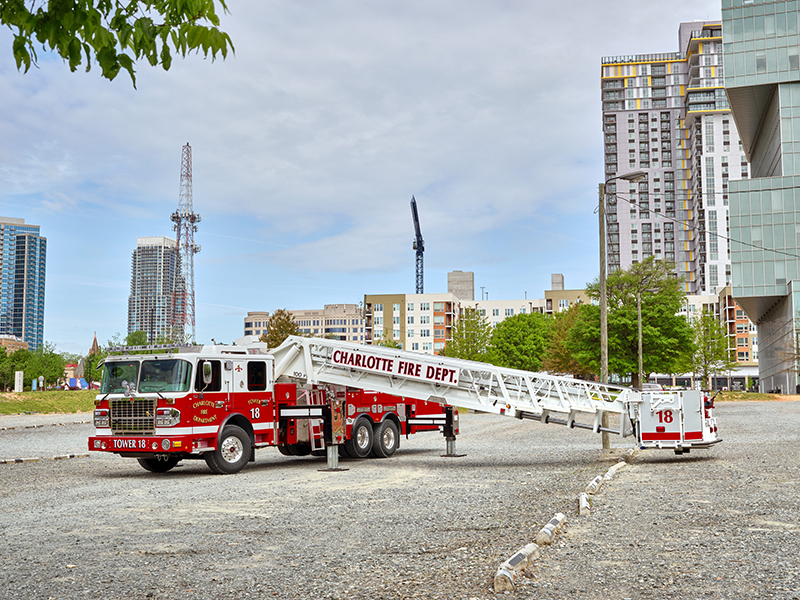
1 This Spartan Emergency Response mid-mount platform built for the Charlotte (NC) Fire Department shows its below-grade abilities. (Photos 1-2 courtesy of Spartan Emergency Response.)

2 This Smeal rear-mount aerial platform built for the Hamburg (NY) Volunteer Fire Department is operating below grade at full extension.

3 KME built this 102-foot mid-mount platform for the Linglestown (PA) Fire Co. No. 1. Note the mitered corners on the platform and the rear of the truck body to minimize tail swing. (Photos 3-4 courtesy of KME.)
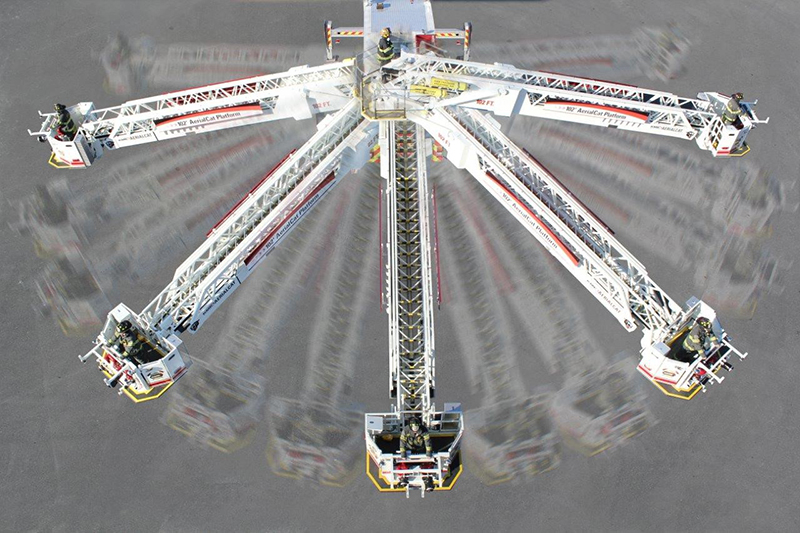
4 This composite photo shows the wide rotational area of KME’s 102-foot rear-mount AerialCat platform.
Justin Howell, southeast region sales territory manager for Sutphen Corp., says that Sutphen has always been a mid-mount company but that it does build rear-mounts too, even though the majority of its business is mid-mounts. “There are certain times when a rear-mount is better than a mid-mount depending on the scene setup,” Howell says, “but for city streets, the mid-mount is a shorter truck and is better because it is not limited in reach.” He notes that while a rear-mount is better for nosing into a tight alleyway, it is limited in reach when working over the front of the truck but that the two pairs of outriggers that stabilize a rear-mount take up more space than the single set of outriggers on a mid-mount.
Zack Rudy, Sutphen’s director of sales, adds driver visibility is much better with a mid-mount because there’s no bucket hanging off the front of the truck. “Also, a mid-mount has a lower center of gravity with the extra weight off the cab, which helps with both braking and acceleration of the truck,” Rudy says. “In addition, a department can get a true raised roof cab on a mid-mount. But in the end, the decision on which type of aerial comes down to customer preference where we have to understand their needs and recommend the aerial that’s right for their department.”
Justin Rice, North American aerial sales manager for E-ONE, notes that E-ONE is predominantly a rear-mount aerial company, selling upward of 90% of those aerials annually. “In the last four or five years, we’ve seen a push toward mid-mounts from some departments but find that departments usually chose to go with what they already have, whether it be mid-mount or rear-mount,” Rice says.
Rice lists the advantages for a mid-mount as having a lower overall height, a good complement of ground ladders, and being able to position the truck well for almost every situation. He says the advantages of a rear-mount are greater compartment space, less tail swing, a longer wheelbase, and the ability to position and operate in a larger window of space.
Mike Watts, national sales manager for Toyne, says a rear-mount aerial has a larger unobstructed range of operation as it sits higher above a taller body, which means the overall height of the apparatus will be taller than a mid-mount. “Usually, in this configuration, the ladders are stored inside the torque box, and from the rear-mounted pedestal there is a clear 360-degree operating envelope above cab/body height and, in some instances, a lower negative operating envelope to the side and rear for about a 180-degree arc,” Watts says.
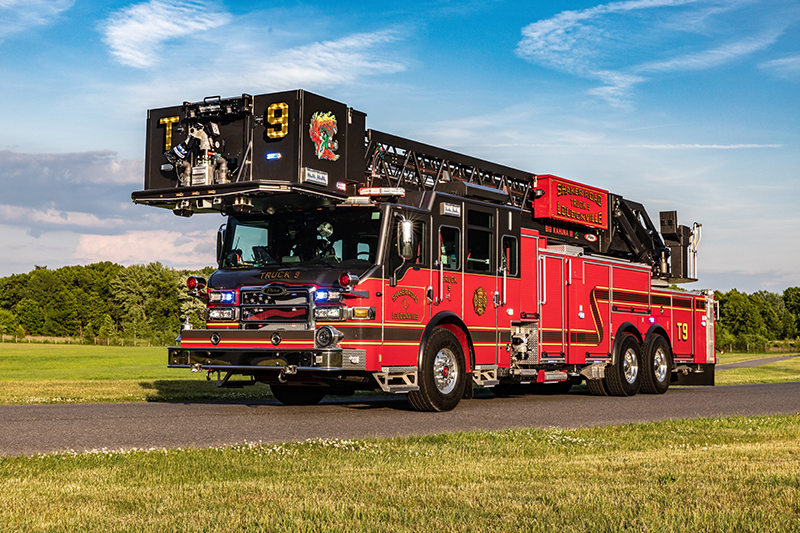
5 Pierce Manufacturing built this Ascendant 110-foot rear-mount aerial platform for the Shaker Road-Loudonville (NY) Fire Department. (Photos 5-6 courtesy of Pierce Manufacturing Inc.)

6 The Sault Ste. Marie (MI) Fire Department had Pierce build this 100-foot Ascendant mid-mount aerial platform.
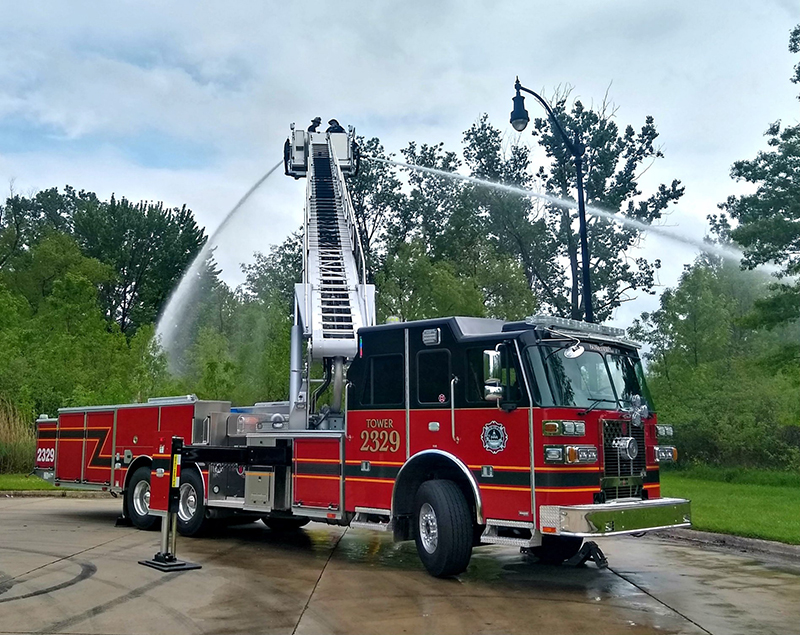
7 This Sutphen Corp. SPH 100 mid-mount aerial platform is set up and operating two monitors in a training session. (Photos 7-8 courtesy of Sutphen Corp.)
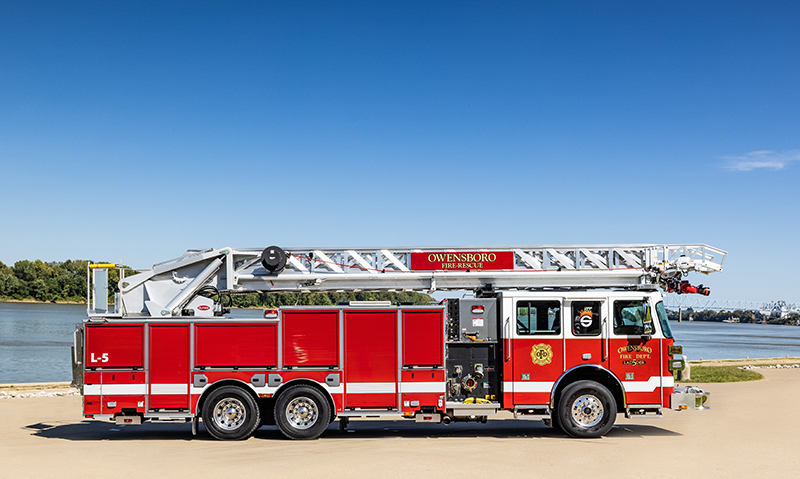
8 Sutphen built this SLR 108 rear-mount aerial ladder for Owensboro (KY) Fire Rescue.
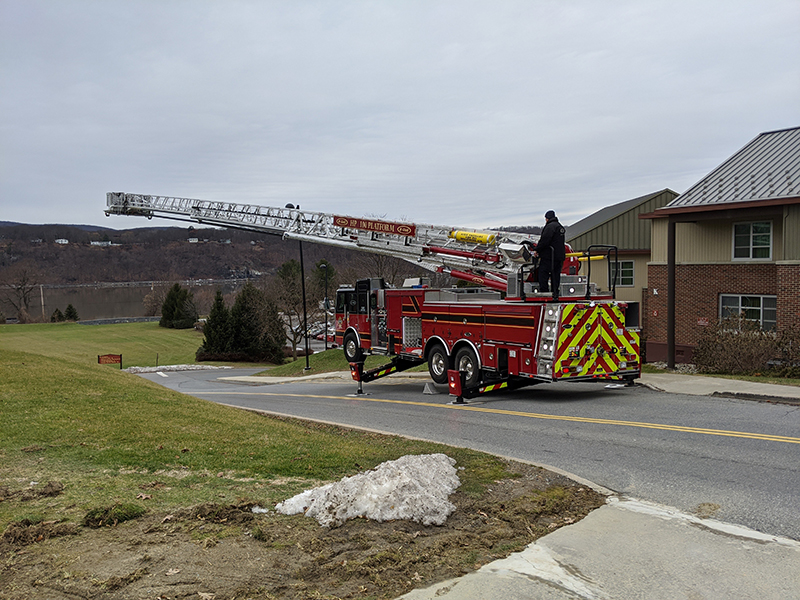
9 E-ONE’s HP 100 aerial platform is shown operating over the front of the truck. (Photos 9-10 courtesy of E-ONE.)
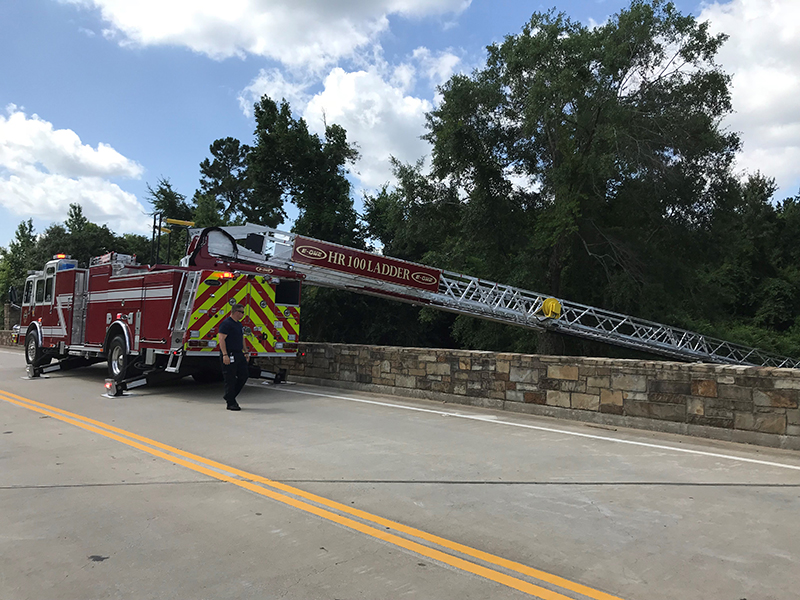
10 An E-ONE HP 100 aerial ladder operates below grade.
Watts notes, “Straight stick aerials work very well in a rear-mounted configuration, as any overhang does not impede the driver and officer’s upward view as with a platform. With a mid-mount aerial, the pedestal is mounted right behind the cab and usually sits a foot or more lower than on a rear-mount aerial. This configuration works well in limited height door openings as seen in many older firehouses. Ladder storage on a mid-mount is limited even if available in the torque box, so many mid-mount aerials store the ground ladders outside on top of the officer’s side compartments.”
He points out mid-mount apparatus can be longer from bumper to bumper than a rear-mount, depending on the manufacturing layout. “The mid-mount can have a more limited operational envelope, depending on the initial truck setup and the direction of the incident from the truck,” Watts notes. “The length of the rear body affects the offset reach straight back, and the cab can come into play in the forward direction. The biggest operational challenge can be below-grade operations where the body and outriggers can limit the downward movement of the mid-mount aerial in more positions as opposed to the rear-mount. Proper setup is the key to success regardless of the pedestal location. There are challenges with each type of truck.”
ALAN M. PETRILLO is a Tucson, Arizona-based journalist, the author of three novels and five nonfiction books, and a member of the Fire Apparatus & Emergency Equipment Editorial Advisory Board. He served 22 years with the Verdoy (NY) Fire Department, including in the position of chief.

